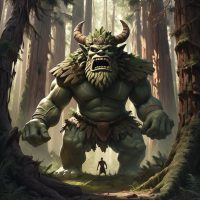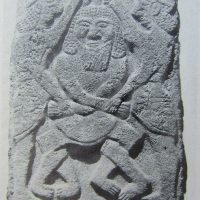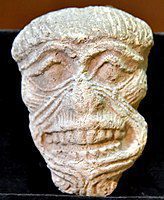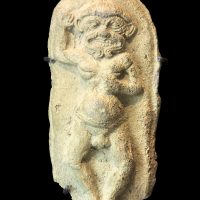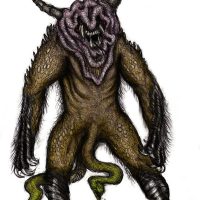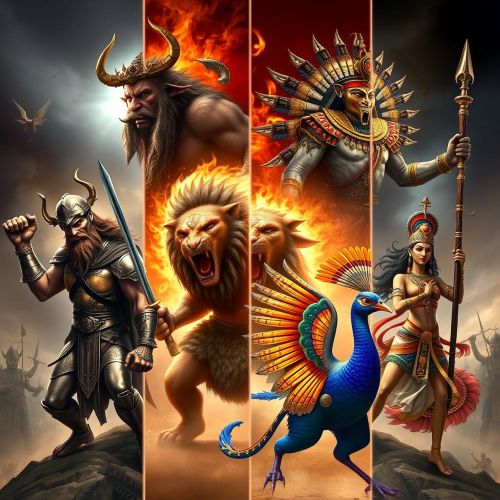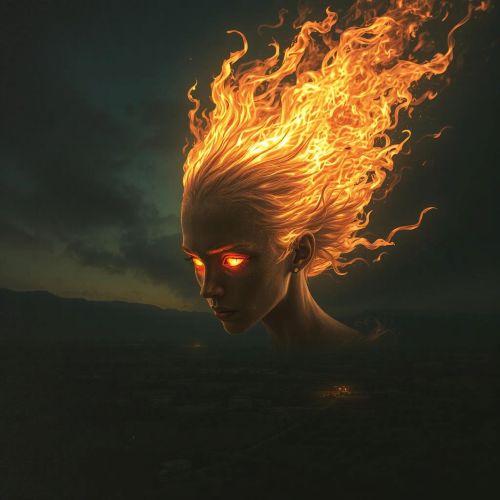Humbaba : Guardian of the Forest
Listen
At a glance
| Description | |
|---|---|
| Origin | Sumerian Mythology |
| Classification | Hybrids |
| Family Members | N/A |
| Region | Lebanon |
| Associated With | Supernatural Powers, Cedar Forest |
Humbaba
Introduction
Humbaba, known alternatively as Huwawa, emerges as a prominent figure within Mesopotamian mythology, particularly in tales involving the hero Gilgamesh. Revered as the guardian of the cedar forest, Humbaba’s origins trace back to his appointment by the deity Enlil as the protector of this sacred realm. His character, shrouded in mystery and power, embodies the awe-inspiring forces of nature and serves as a formidable obstacle to those who dare to trespass into the domain of the gods.
In the ancient epic of Gilgamesh, Humbaba looms large as a monstrous antagonist, presenting a formidable challenge to the hero’s quest. The narrative unfolds with Humbaba as the dread of humanity, his dominion over the Cedar Forest posing a threat to mortals and gods alike. Despite his fearsome reputation, Humbaba’s role extends beyond mere villainy, symbolizing the untamed wilderness and the inherent struggle between civilization and the natural world.
Throughout millennia, Humbaba’s tale has endured, captivating audiences with its themes of heroism, morality, and the consequences of power. His clash with Gilgamesh remains a timeless narrative of good confronting evil, resonating across cultures and generations. As one of the oldest surviving works of literature, the Epic of Gilgamesh ensures that Humbaba’s legacy endures, a testament to the enduring power of myth and the human imagination.
Physical Traits
Humbaba’s physical appearance is subject to interpretation, with various depictions portraying him as a monstrous giant, ogre, or demon. In the Epic of Gilgamesh, he is described as a colossal figure with a voice akin to thunder and a breath that brings death. Some representations highlight his monstrous features, including wide eyes and multiple heads, emphasizing his association with the wild and untamed aspects of nature.
The ambiguity surrounding Humbaba’s form adds to his mystique, prompting speculation among scholars about his origins. Some suggest he may have originated as a nature deity before evolving into a fearsome guardian. This uncertainty contributes to interpretations that underscore the conflict between civilization and the wilderness.
In the epic, Humbaba’s presence instills fear in all who encounter him. His colossal stature, covered in impenetrable scales resembling cedar bark, dwarfs even the mightiest warriors. His face is described as a grotesque fusion of human and animal features, with bulging eyes radiating an otherworldly intelligence and a mouth filled with razor-sharp teeth. Despite his terrifying appearance, Humbaba also exudes a certain majestic beauty, symbolizing the awe-inspiring grandeur of the natural world revered by the ancient Mesopotamians.
Family
In Babylonian mythology, Humbaba stands as the solitary guardian of the Cedar Forest, tasked with safeguarding its mysteries from trespassers. However, some interpretations suggest familial connections, potentially linking him to mythological beings like the god Enlil, possibly his father. This familial tie adds depth to Humbaba’s character, suggesting a deeper mythological significance beyond his role as a mere protector.
Yet, information regarding Humbaba’s family lineage remains scant. The Epic of Gilgamesh briefly mentions seven sons who perish alongside him in battle, but no further details regarding a wife, parents, or other relatives are provided. This apparent isolation reinforces Humbaba’s portrayal as a solitary entity, a formidable guardian bound to the Cedar Forest. Despite Humbaba’s prominence in Mesopotamian mythology, details about his family remain elusive. According to some accounts, he was raised by Utu, the Sun, and appointed by Enlil, the king of the gods, to fulfill his role as the guardian of the Cedar Forest.
Other names
While Humbaba is commonly recognized by this name in mythological narratives, he is also identified by various titles across different texts and traditions. In certain versions of the Gilgamesh epic, he appears as Huwawa, while other ancient texts refer to him as Khumbaba or Huwawu. These alternative appellations highlight the diverse oral traditions prevalent in the ancient Near East, illustrating the manifold ways in which Humbaba’s legend has been transmitted through the ages.
Humbaba’s identity is intertwined with multiple names, showcasing the rich tapestry of Mesopotamian cultural influences. The oldest recorded form of his name is Ḫuwawa, as evidenced in ancient texts from Mari and Tell Harmal, where it appears as Ḫu-bi-bi, possibly indicating a pronunciation akin to /Ḫuppipi/. Across different languages and sources, his name varies: in Akkadian, the primary language of Babylonian Mesopotamia, he is referred to as Humbaba (Ḫumbaba), while in Sumerian, he is known as Ḫuwawa (Ḫu-wa-wa). These linguistic variations likely mirror the evolution of the myth across diverse Mesopotamian cultures over time.
Powers and Abilities
Humbaba’s formidable presence is marked by his immense physical strength and terrifying aura. Descriptions paint him as capable of roaring with such force that it could shake mountains, while his fiery breath is said to bring swift death to any who encounter it. Moreover, Humbaba is attributed with unparalleled control over the cedar forest, his ears attuned to its whispers from miles around.
While some interpretations hint at the possibility of shape-shifting or command over monstrous creatures, these abilities are not explicitly outlined in major sources. Nevertheless, Humbaba’s power is unmistakable, particularly underscored by his role as the guardian of the cedar forest. In Mesopotamian culture, cedar trees held significant value, serving both practical and religious purposes. Humbaba’s guardianship thus symbolizes control over a precious resource, further solidifying his formidable stature.
Despite his fearsome reputation, Humbaba exhibits moments of humanity, adding complexity to his character. Following his defeat, he pleads for mercy and even offers to serve Gilgamesh if spared. Such nuances highlight Humbaba’s multifaceted nature, transcending mere villainy to embody themes of power, mercy, and the complexities of the human condition.
Humbaba’s story intricately weaves into the fabric of the Epic of Gilgamesh, a narrative that follows the exploits of the powerful yet prideful king, Gilgamesh. Driven by his ambition, Gilgamesh embarks on a perilous quest to conquer the cedar forest, guarded vigilantly by the fearsome Humbaba. Alongside his companion Enkidu, a wild man fashioned by the gods, Gilgamesh faces a series of daunting trials within the forest’s depths, culminating in a dramatic confrontation with the imposing guardian.
Despite initial trepidation, Gilgamesh ultimately prevails over Humbaba, aided by the intervention of the sun god Shamash. However, this pivotal moment in the epic prompts deeper contemplation, as it raises questions about the ethical implications of violence and the potential disruption of ecological equilibrium. Recent discoveries of additional fragments of the Epic of Gilgamesh shed new light on Humbaba’s character, suggesting a more nuanced portrayal that challenges traditional perceptions of the guardian. These revelations invite reevaluation of Humbaba’s role, offering a glimpse into a narrative that transcends conventional heroism to explore themes of morality and ecological stewardship.
Modern Day Influence
Humbaba’s enduring presence transcends the ancient myths of Mesopotamia, leaving an indelible mark on modern artistic and literary landscapes. In fantasy and role-playing games, he often emerges as a formidable boss character, his monstrous form striking fear into players’ hearts. Yet, beyond mere entertainment, Humbaba’s story resonates as a cautionary tale, warning against the perils of unchecked ambition and the imperative of respecting the natural world.
The ambiguity surrounding Humbaba’s character invites contemporary interpretations, further enriching his legacy. Some perceive him as a symbol of untamed nature, simultaneously destructive and awe-inspiring in his primal power. Others view him as a tragic figure, a guardian whose domain is violated by human greed in the relentless march of progress.
Humbaba’s influence extends beyond the realm of Mesopotamian mythology, leaving traces in various cultural narratives. Iconographic similarities between Humbaba and figures like the gorgons in Greek mythology suggest a lasting impact on artistic representations. Moreover, echoes of his legend can be found in texts such as the Book of Giants in Jewish and Manichaean traditions, as well as in Islamic literature.
In the modern era, Humbaba’s myth continues to captivate and inspire creators across diverse media. From literature to art to popular media, his story is reimagined and retold, exploring themes of power, nature, and the human condition. In recent years, Humbaba has experienced a resurgence in popular culture, with appearances in video games, television shows, and novels. Contemporary artists seize upon his image, reinterpreting it to delve into the timeless complexities at the heart of his legend. Through these myriad interpretations, Humbaba’s legacy endures as a testament to the enduring power of myth and its ability to transcend time and culture.
Related Images
Frequently Asked Questions
What is lorem Ipsum?
I am text block. Click edit button to change this text. Lorem ipsum dolor sit amet, consectetur adipiscing elit. Ut elit tellus, luctus nec ullamcorper mattis, pulvinar dapibus leo.
What is lorem Ipsum?
I am text block. Click edit button to change this text. Lorem ipsum dolor sit amet, consectetur adipiscing elit. Ut elit tellus, luctus nec ullamcorper mattis, pulvinar dapibus leo.
What is lorem Ipsum?
I am text block. Click edit button to change this text. Lorem ipsum dolor sit amet, consectetur adipiscing elit. Ut elit tellus, luctus nec ullamcorper mattis, pulvinar dapibus leo.
What is lorem Ipsum?
I am text block. Click edit button to change this text. Lorem ipsum dolor sit amet, consectetur adipiscing elit. Ut elit tellus, luctus nec ullamcorper mattis, pulvinar dapibus leo.
What is lorem Ipsum?
I am text block. Click edit button to change this text. Lorem ipsum dolor sit amet, consectetur adipiscing elit. Ut elit tellus, luctus nec ullamcorper mattis, pulvinar dapibus leo.

